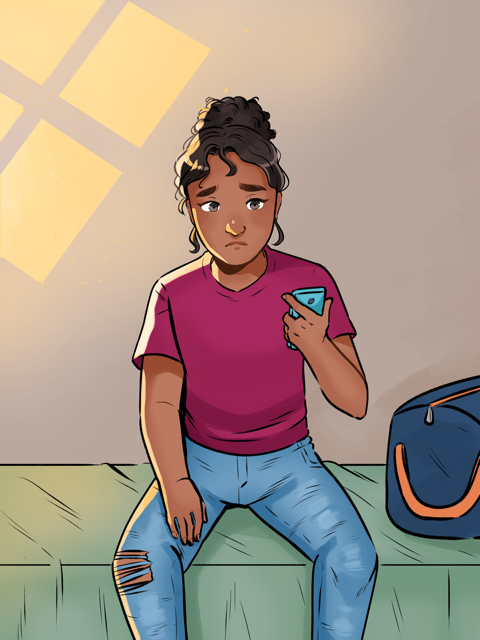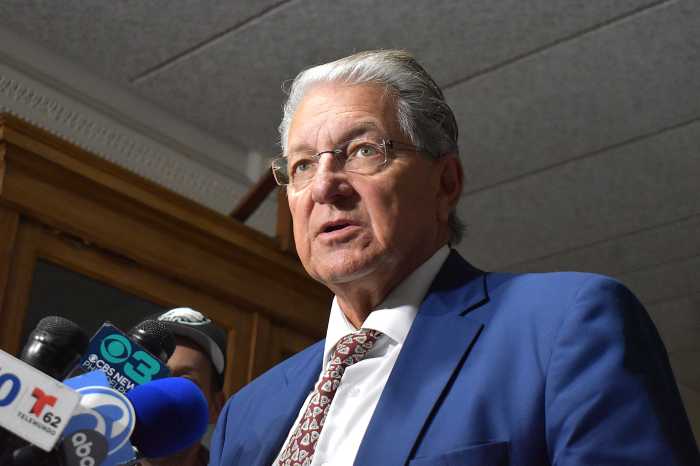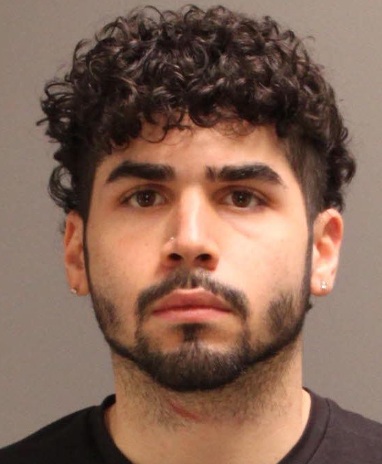Usually, a stranger called Lexi Andino on her cellphone — “They would just tell me I’m getting a new caseworker.”
Andino, now 25, received that call throughout her 11 years in foster care. “I would guess it was 15 or 20 caseworkers I had. I stopped counting.”
Philadelphia deploys a two-pronged system to provide family and child services — government-employed staff, to investigate alleged child abuse and neglect cases; and private, contracted agencies that take the cases from there, providing in-home services to families or placements in foster care.
Increased turnover currently plagues both.
Worker shortages among contracted agencies spiked to 45-percent last year, and this April, according to AFSCME Local 2187 union president David Wilson, the crisis reached inside Philadelphia’s Department of Human Services, creating a 35-percent vacancy rate among child abuse and neglect investigators.
An internal email circulated to DHS staff and obtained by Metro Philadelphia revealed a backlog of 100 cases awaited investigation, causing DHS administrators to press hotline staff into field work.
Such worker shortages cause painful delays for kids, parents and foster parents.
Pretty much everything in a child’s life gets routed through their caseworker, says Andino, including whether that child lives with family or in a stranger’s house, medical decisions, educational conferences and more.
“Some things get lost,” says Andino. “Some decisions get left unmade or they change. Some workers are more willing to help and others aren’t as willing, especially when they just meet you.”
The age of the current workforce crisis might be its most salient feature. Andino averaged more than one caseworker per year prior to the current shortage.
Marcía Hopkins, a social worker at Juvenile Law Center, calls the problem a “constant topic” among young people in foster care, with this post-Covid spike just being the latest iteration. A foster care alum herself, Hopkins recalls one case manager whose consistent effort influenced her to pursue social work. That case manager, she says, even “baked me a cake for my birthday every year.”
Today, however, she recognizes high turnover as a norm.
“The field has always had a worker shortage,” she says. “It’s hard to keep people in a job that’s so dysfunctional.”
Across the nation, over the last 40 years or more, turnover in child welfare often meets and exceeds rates in similarly high-stress industries like law enforcement, fire-fighting and EMS. Workers also face increased scrutiny for racial bias and unnecessarily separating families over economic problems, raising concerns that work in child welfare is becoming stigmatized.
A problem this entrenched might appear unsolvable, but experts cite a promising model for child welfare reform and workforce stability: New Jersey, which changed how their entire foster care system operates, allowing workers to do more caring work and dramatically reduce the number of kids in foster care.
The “dark past”
When Nancy Carre-Lee first worked as a case manager in New Jersey, about 30 years ago, overwork was the job.
“I had a caseload of 100 kids,” she says, “and everyone else around me had 100 kids, and we didn’t know anything different. We were just putting out these fires.”
Carre-Lee, now Executive Director of Staff Health and Wellness, recalls that time period as New Jersey’s “dark past.”
“If you burned out, you burned out,” she said.
Children paid the steepest price, provoking a class action lawsuit on behalf of kids allegedly abused and neglected while in the state’s care. The suit dragged on until a highly publicized child death finally provoked them to stop fighting and start fixing the problems they should have been focused on from the beginning. A subsequent settlement placed the state’s child protective services under federal supervision these past 20 years, an arrangement slated to end soon because the entire system appears transformed.
The foster care population fell from about 13,000 to about 3,000 today, as the state shifted its priorities from separating families to providing services. To put that drop in perspective, the city of Philadelphia (population 1.6 million) has about 300 more kids in foster care than the entire state of New Jersey (population 9.3 million).
New Jersey also diminished “stranger” care, placing most kids removed from their homes with kin, a research-backed initiative that protects children against dangerous long-term mental and physical health effects.
New Jersey hired 600 additional case workers with increased salaries and reasonable caseloads. Child welfare experts call caseload size key to lowering the foster rolls and retaining staff, allowing social workers to spend additional time with their client families.
“You get to really know the families because you’re not always just putting out fires,” says Mary Coogan, President and CEO of Advocates for Children of New Jersey, so the case manager might be more comfortable leaving the child in the home, “and you get to know the uncles, the aunts, the grandparents. … It makes a big difference.”
In Jersey’s dark days, as Carre-Lee puts it, overloaded case managers sometimes felt compelled to remove kids and put them “someplace until we figure out what’s going on.” Today, New Jersey case managers carry only about six families each. Each manager also averages just three foster care placements, another key metric, as kids in government care require far more labor scheduling visits, doctor’s appointments, school meetings and more.
By comparison, Philly DHS’s publicly released data through 2022, predating the current turnover spike, indicates their contracted case managers carry caseloads about twice New Jersey’s size, at 11 each.
This contrast reveals a big reason why New Jersey enjoys remarkable workforce stability, posting annual turnover rates since 2006 of just six- to 10-percent, while Philly workers flee. Last year, a taskforce assembled to look at Philadelphia’s private staff crisis surveyed workers, yielding findings that echo decades of academic research: Workers leave child welfare for multiple reasons, including wages so low they work second jobs, high caseloads, stress, long hours, poor work-life balance, and frustration that the job’s demands prevent them from spending time with their child and family clients.
Case worker salaries in New Jersey start at about $55,000, while beginning salaries for private and government-employed Philadelphia caseworkers run between $43,000 to $46,000. A DHS spokesperson says the department is working with the city’s office of human resources—which sets pay rates—to examine its internal pay scale.
Earlier this year, DHS committed to a 25-percent salary bump at the city’s Community Umbrella Agencies, the network of private providers DHS passes cases to after conducting the initial investigation, to bring CUA salaries more in-line with DHS staff and better compete with the broader healthcare field. Pennsylvania Department of Human Services officials granted only a portion of that line item in the city’s budget request, according to a Philly DHS spokesperson, but “DHS is committed and will continue to explore ways to support the CUA salary increases for FY ’24.”
This suggests the issue here is money, but Marcia Lowry, the attorney who originally sued the Garden State, says the differences between functional and dysfunctional child welfare systems run deeper than that.
“The resources help,” says Lowry, “but when you look at functional systems, it’s more about how they spend what they have.”
By the numbers
Pennsylvania currently has roughly 13,000 kids in foster care, separating families at a rate more than three times that of New Jersey. When comparing New Jersey and Philadelphia, looking at the city’s report covering the end of last year, and factoring in the total number of children in each place, this city removes kids at a rate nearly 7 times higher than Jersey. Poverty levels for Philly versus New Jersey don’t explain this discrepancy away either. If removals are calculated against the total number of kids in poverty, a standard talking point for child welfare professionals, Philly puts children in foster care at a rate almost three times that of our cross-bridge neighbor.
Looking at past spending data from 2020, according to a report by the research organization Child Trends, New Jersey’s total spending isn’t extreme. In fact, the amount of federal, state and local dollars spent on kids in Pennsylvania is actually higher than New Jersey.
At least some of this difference probably traces back to Pennsylvania’s heavier reliance on the most expensive, labor intensive and traumatic form of child welfare service: foster care. Based on the total kids living in each state, there is $712.55 spent per child in Pennsylvania, compared to $563.82 spent in New Jersey.
Philly DHS has planned a trauma-informed transformation project to help staff and their clients. But here, too, Jersey offers fuller support, including an internal podcast for staff, wellness activities and workshops for meditation, yoga and trauma training, placed on every employee’s job calendar, enabling them to opt-out from aids rather than opt-in and risk stigmatizing themselves.
Jody Levison-Johnson, president and CEO at Social Current, which is partnering with the Health Federation of Philadelphia to provide DHS’s upcoming trauma training, acknowledges the importance of retention efforts but suggests turnover also presents an opportunity for change.
“We can address the supply side,” she says, “by hiring more workers. But if you think about this over-surveillance of families that happens, if we were able to really shift the paradigm toward strengthening families and moving to more upstream preventive resources, you can reduce the demand. And I feel like the choice is sort of ours.”
Remarkably, the union representing city workers agrees with this assessment, saying Philadelphia overloads its staff by over-policing families. The admission suggests another fundamental lesson New Jersey offers: Philadelphia might better retain child welfare staff by trusting them, and families, more.
Mandatory second investigation
When Philadelphia’s case workers investigate a complaint, says Wilson, the union rep for DHS social workers, they probe every aspect of a family’s life. Whether the complaint involved abuse or neglect, they inspect for bruises, assess the child’s overall health, examine housing conditions, check cupboards and refrigerators, ask questions about the entire family’s mental and physical health, substance use, discipline habits, parental co-sleeping and privately interview each child living at that address.
If no problems appear, Pennsylvania state policies allow investigators to close the case. New Jersey functions the same way. Philadelphia, however, requires case managers to visit the family a second time and privately interview every child again.
For child advocates, this might sound like a good thing. Check and recheck. But imagine your parenting questioned by someone with a bias toward over-protection and the power to take your child. Imagine the anxiety and confusion felt by a child, asked twice, by a stranger in their home, if they suffer abuse.
Imagine this, too, from the social worker’s vantage. Everything’s fine here. Other families require visits. But you must take these additional steps, putting this family and yourself through the unnecessary stress of an additional investigation, or face disciplinary action.
According to Wilson, Philly instituted this policy after the tragic, 2006 starvation death of Danieal Kelly, which resulted in the criminal conviction of a DHS social worker. The fear of child-related tragedies, understandably, drives not just Philadelphia but the child welfare field. Guarding against deeply unlikely tragedies, however, sweeps kids and families up unnecessarily, ballooning the foster care system to more than 390,000 kids nationwide. Only about 15-percent of these kids suffered alleged abuse. More often, agencies remove kids for “neglect,” a broad term often traceable to poverty. Removals also disproportionately involve black families nationally and in Philadelphia, where Black people comprise about 42 percent of the population and more than 60 percent of the youth in foster care.
Wilson describes workers being seen as “villains” in the community, reflecting a broader discussion within child welfare.
“The kinds of things we hear from our members,” says Christine James-Brown, president and CEO of the Child Welfare League of America, “is that calls for racial equity are having an impact. What do your family and neighbors think of your job? That’s important.”
Workers also recognize that some reformist complaints about child welfare ring true.
“People are so frustrated when they go into child welfare. They thought they would be applying their clinical expertise, and bring their compassion and commitment to families,” says James- Brown. “But they’re all caught up in the legal responsibilities that drive the field of child welfare. They are caught up in recording information. They’re caught up at so many other things that it’s difficult to even bring your clinical knowledge to the field.”
Philly’s policy of checking and rechecking comprises a primary example, replacing the social worker’s judgment with that mandatory second investigation.
Philadelphia made significant strides in the last five years, adopting a policy to “right size” its system and lowering the number of kids in foster care by more than 40-percent since 2017. An agency spokesperson, in an email, stated that DHS is “reviewing” the current requirement for making at least two visits with the child during an investigation and “will announce the changes, when finalized.” For now, however, the city still has higher removal rates of children in poverty than New York, Chicago, and other big cities, and both New Orleans and New Jersey reduced their foster rolls by far greater rates than Philly, 75- to 80-percent, without suffering increases in maltreatment.
New Jersey still has its problems. The private contractors the state engages to provide some child welfare-related services currently suffer high turnover rates. And the agency still separates Black families disproportionately. But the state’s experience provides a template for large-scale improvement.
“I recommend that people look at New Jersey because it shows what you can do,” says Lowry, the attorney who filed the class action lawsuit that started all this change. “And it’s about investing in the right things—on services for families, to keep them together or reunite them…and keeping caseload sizes down. It takes real perseverance over time, but it can be done.”
A department that functions this effectively might look far away. But Andino knows what she missed.
“I would have had a better connection with the workers,” she says, “and I feel like that would have helped me stay on track with my dreams and goals. After having so many workers, I just stopped trying to connect with any of them at all.”

Metro Philadelphia is one of more than 20 news organizations producing Broke in Philly, a collaborative reporting project on economic mobility. Read more at brokeinphilly.org or follow on Twitter at @BrokeInPhilly. Our Kids is a project of the Broke in Philly reporting collaborative examining challenges and opportunities facing Philadelphia’s foster care system. Steve Volk is an investigative solutions reporter with Resolve Philly.





























